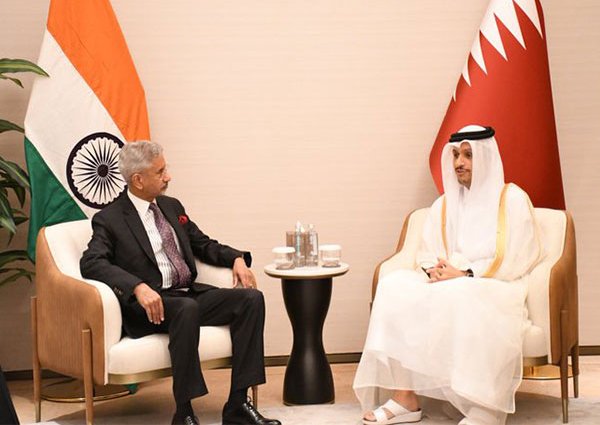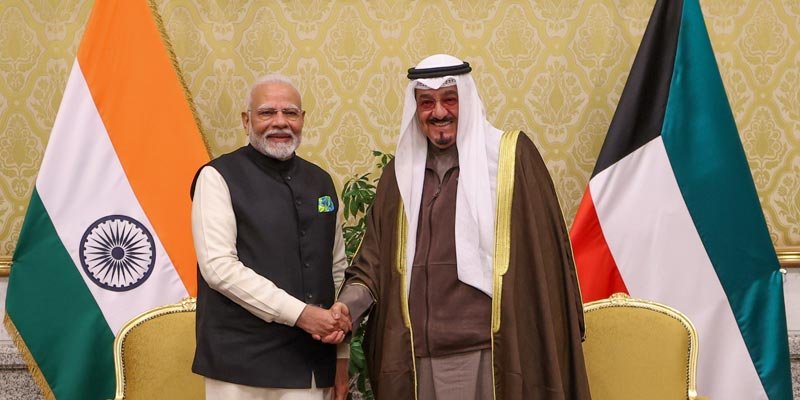As the year 2024 wraps up, a close analysis of India’s external engagement with the world shows that New Delhi continues to lay focus on the Gulf region for its energy security, trade, defence, and security, which have in essence become a key factor in deepening relationship between the two sides, which are now exploring collaboration in areas like science and technology, renewable energy, connectivity, and climate change.
In the world, if any region has received the highest number of high-level visits from India in the last 10 years, then it is the Gulf. Just a week after the first ever prime ministerial visit to Kuwait in 43 years, External Affairs Minister Dr S Jaishankar made a three-day official trip to Qatar, beginning from December 30.
In substance, it represents the significance of the region for India and it can be more clearly understood by the fact that in the past one-decade, Indian PM Modi has embarked on 15 state-level and official-level trips to the Gulf countries, starting with the UAE in August 2015.
Separated by the Arabian Sea, why has India given prominence to the Gulf? This question has gained prominence ever since Modi chose Kuwait, a tiny Gulf country for his state visit.
He was the first Indian Prime Minister to visit Kuwait after more than four decades and this itself suggested that India would not have selected the country without some valid reasons for the prime ministerial trip. Kuwait is the current chair of the six-member Gulf Cooperation Council which comprises Saudi Arabia, Kuwait, the UAE, Qatar, Bahrain, and Oman.
Since the international order remains in a flux and new challenges continue to confront the policy makers, the Gulf region has served as a beacon of peace, stability, and progress. Moreover, it has seen a rise in influence in global diplomacy, especially within the UN
Importance of Gulf in India’s Strategic Calculus
Since the international order remains in a flux and new challenges continue to confront the policy makers, the Gulf region has served as a beacon of peace, stability, and progress. Moreover, it has seen a rise in influence in global diplomacy, especially within the UN. With New Delhi lobbying hard for the reform of the UNSC, Kuwait and the GCC’s support for India’s bid for the Security Council is considered necessary.
Along with this, the region wears strategic significance on its sleeve. Its location not far away from India and growing activity of international players like China, makes India forge closer cooperation with the region, both for its energy and national security. Elevation of its bilateral relation with Kuwait to strategic partnership, indicates it in clear terms.
After Oman, the UAE and Saudi Arabia, Kuwait has become the 4th country among the GCC to have strategic partnership with India. And its significance can be seen in New Delhi’s decision to join the inaugural India-GCC Ministerial Meeting for Strategic Dialogue, which was held on September 9 in Riyadh.
“The GCC is a cornerstone of global energy supply. India is one of the world’s largest and fastest-growing markets. Much of the future demand is going to come from us. Our deeper collaboration will help in stabilising markets, driving innovation, and enhancing energy security.” External Affairs Minister Dr S Jaishankar said in his opening statement at the India-GCC Ministerial Meeting for Strategic Dialogue.
After Oman, the UAE and Saudi Arabia, Kuwait has become the 4th country among the GCC to have strategic partnership with India. And its significance can be seen in New Delhi’s decision to join the inaugural India-GCC Ministerial Meeting for Strategic Dialogue
Energy Security
The GCC’s substantial oil and gas reserves are of immense importance for India’s energy security, given that New Delhi will become the largest source of global oil demand growth between now and 2030.
As per data from OPEC, Saudi Arabia, the UAE, and Kuwait have 38.8% of the world’s total oil reserves, while proven gas reserves in the Gulf countries are around 58 trillion cubic metres. Kuwait holds 6% of the world’s proven oil reserves, including half of the reserves in the Natural Zone that is shared with Saudi Arabia. The GCC countries contribute 35% of India’s oil imports and 70% of gas imports.
Increasing Trade and Investments from Gulf
In terms of trade and commerce, the Gulf countries are India’s second most important trade destination after the US. During 2023-24, India-GCC bilateral trade stood at $161.59 billion. India’s exports were $56.3 billion in 2023-24, and imports were $105.3 billion.
Among the GCC countries, the UAE has led the group in having the highest volume of trade with India in 2023-24. During the last financial year, the two-way trade between India and the UAE stood at $83.65 billion, while it was $43.3 billion with Saudi Arabia, $14.08 billion with Qatar, $10.47 billion with Kuwait, $8.9 billion with Oman and $1.7 billion with Bahrain.
The GCC countries are also important for India in terms of investment. For example, Kuwait possesses a sovereign wealth fund of about $1 trillion; it is the 5th largest sovereign wealth fund in the world.
The GCC’s substantial oil and gas reserves are of immense importance for India’s energy security, given that New Delhi will become the largest source of global oil demand growth between now and 2030
Given this, India wants to see that Kuwait’s investment in India is increased. At the present, however, among Gulf nations, the UAE is a major investor in India with its foreign direct investment in infrastructure, manufacturing, and other sectors reaching $19 billion between April 2000 and June 2024. During 2023-24, the UAE invested $2.9 billion in India.
On the other hand, foreign direct investment from Saudi Arabia till March 2024 was $3.226 billion. Its major investments include Public Investment Fund. However, during his visit to New Delhi in February 2019, Saudi Crown Prince Mohammed bin Salman Al Saud had announced that Riyadh would be investing $100 billion in India in diversified sectors such as energy, refining, petrochemicals, infrastructure, agriculture, minerals, and mining, manufacturing, education, and health in coming years.

But Oman has adopted a different way of investment in India and it does so through numerous joint ventures. There are more than 6000 India-Oman joint ventures with an estimated investment of over $7.5 billion.
Likewise, Qatar’s investment in India is increasing, especially after it formed Qatar Investment Authority (QIA) in 2005 to diversify its economy. It has invested in many listed and unlisted companies in India. Since 2020, QIA has invested nearly $5 billion in Indian companies.
Defence and Security Cooperation
In the last 10 years, defence and security have received a significant traction in India’s engagement with the Gulf countries. For example, Oman, which is one of New Delhi’s closest defence partners in the region, is actively engaged with India in joint military exercise, training, information sharing, oceanography, and ship building. Both countries are now focusing on defence industries collaboration.
Kuwait has signed a defence agreement with India during Prime Minister Modi’s recent visit. It will lead to institutionalisation of defence cooperation that includes training, exchange of personnel and experts, joint exercises, supply of defence equipment, and collaboration in research and development.
India wants to see that Kuwait’s investment in India is increased. At present, however, among Gulf nations, the UAE is a major investor in India with its foreign direct investment in infrastructure, manufacturing, and other sectors reaching $19 billion between April 2000 and June 2024. During 2023-24, the UAE invested $2.9 billion in India
In the past one-decade, bilateral defence engagement between India and the UAE has been growing with each year passing. Armies of the two countries held their first joint exercise called ‘DESERT CYCLONE’ in January 2024 at Mahajan range in Rajasthan. Earlier, IAF participated in a bilateral exercise with the UAE counterparts in May 2016 and UAE Air Force Officers participated as Observers in the Trilateral Air Exercise on Humanitarian Assistance & Disaster Relief (HADR) theme held in March 2018.
High-level exchanges between India and the UAE at the level of Service Chiefs are going-on along with functional level exchanges and military education exchanges between the two countries. The naval ships of India and the UAE have regularly made port calls, while these two countries annually conduct defence dialogue to discuss the security and defence cooperation. Through bilateral tools like the Joint Defence Cooperation Committee (JDCC), the two countries deliberate ways to further strengthen defence and security cooperation.
India and Saudi Arabia held their first joint military exercise ‘SADA TANSEEQ’ at Mahajan range in Rajasthan from January 29 to February 10, 2024. The two also enjoy extensive naval cooperation. Till now, two editions of the bilateral naval exercise ‘Al Mohed Al Hindi’ have been concluded.
With the help of mechanisms like the Joint Committee on Defence Cooperation (JCDC), the two countries regularly explore ways to strengthen their multifaceted defence cooperation. The two countries are seeking to expand the scope of engagement and cooperation in areas such as military, training, defence industry, and R&D. In February 2024, Saudi Arabia inked a deal for the purchase of $225 million worth of munitions.
In the last 10 years, defence and security have received a significant traction in India’s engagement with the Gulf countries. For example, Oman, which is one of New Delhi’s closest defence partners in the region, is actively engaged with India in joint military exercise, training, information sharing, oceanography, and ship building
India-Bahrain defence relationship is also steadily growing. Recently, with the aim to enhance naval cooperation and augment interoperability with the Royal Bahrain Naval Forces (RBNF), INS Tir and ICGS Veera of First Training Squadron of the Indian Navy, visited the Port of Manama.
Defence cooperation is an important pillar of India’s bilateral engagement with Qatar. India, which offers training to Qatari defence personnel, is a regular participant at the biennial Doha International Maritime Defence Exhibition and Conference (DIMDEX).

Indian Naval and Coast Guard ships regularly visit Qatar as part of the bilateral cooperation and interaction between the two sides. India-Qatar Defence Cooperation Agreement, signed in November 2008, was further extended for a period of five years in November 2018.
In sum, maintaining a healthy relationship with the Gulf countries is the key agenda of India’s foreign policy and regular high-level visits from each side signals it in categorical terms.
With the help of nine million diaspora and ongoing oil trade, New Delhi has, though, maintained its traditional relationship with the GCC, but it wants to walk hand-in-hand with the Gulf countries at the time when they are diversifying their economy.
With the help of nine million diaspora and ongoing oil trade, New Delhi has, though, maintained its traditional relationship with the GCC, but it wants to walk hand-in-hand with the Gulf countries at the time when they are diversifying their economy
India wants to align with Kuwait’s Vision 2035 and strengthen cooperation in the areas like green hydrogen, renewable energy, infrastructure, and technology. It wants enhanced connectivity and economic cooperation with the region.
Moreover, since it has a stake in the region’s stability, it wants the GCC’s cooperation in fighting terrorism, countering money laundering, cyber threats, organised crime, human trafficking, and sea-piracy.
–The writer is a senior journalist with wide experience in covering international affairs. The views expressed are of the writer and do not necessarily reflect the views of Raksha Anirveda






